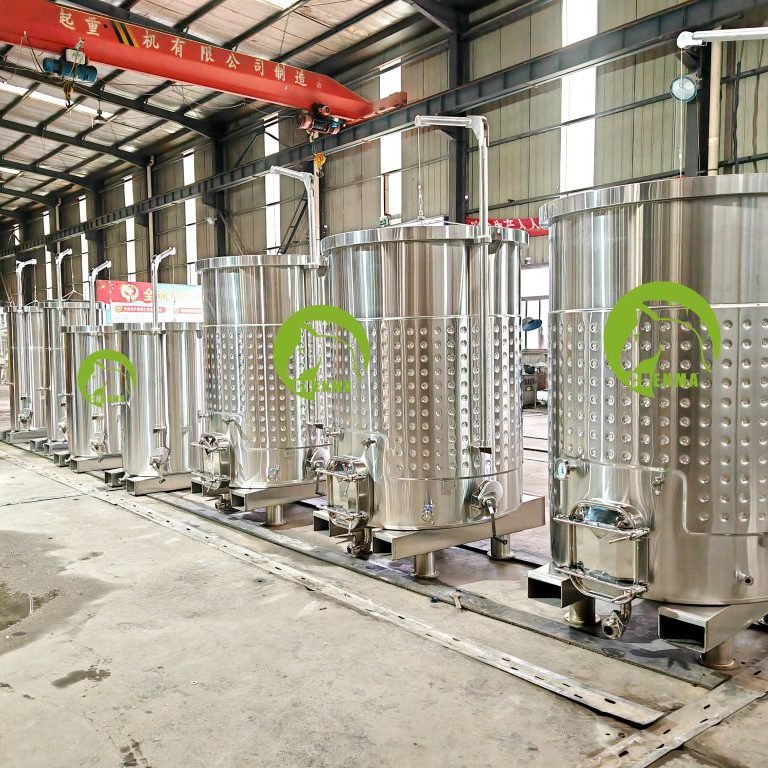Variable Capacity Wine Tank: An Introduction
Variable capacity wine tank, also known as floating lid tanks or variable volume tanks, offer a versatile and practical solution for winemakers dealing with varying production volumes. These tanks are particularly useful for small to medium-sized wineries, experimental batches, or when dealing with fluctuating quantities of wine. Here’s an overview of their features, advantages, and considerations.

1.Features of Variable Capacity Wine Tanks
1).Adjustable Floating Lid:
The defining feature is a floating lid that can be adjusted to match the wine level. The lid can be moved up or down and sealed at any height within the tank, accommodating different volumes of wine.
2).Airlock or Sealing System:
An airlock or sealing system (usually involving an inflatable gasket or seal) ensures that the wine is protected from air exposure, minimizing the risk of oxidation.
3).Stainless Steel Construction:
Typically made from high-quality stainless steel (often 304 or 316 grade), ensuring durability, ease of cleaning, and resistance to corrosion.
4).Versatile Sizes:
Available in a range of capacities to suit different production needs, from small batches to larger volumes.
5).Standard Configuration:
Standard configuration include built-in cooling jackets, sampling ports, racking arms, and thermowells for temperature monitoring.
6).Additional Features:
Some Variable Capacity Wine Tank come with forklift and it can be transportation very conveniently.
2.Advantages of Variable Capacity Wine Tanks
1)Flexibility in Volume:
Allows winemakers to use the same tank for different volumes of wine, making it ideal for varying production scales and experimental batches.
2)Reduced Oxidation Risk:
The adjustable lid minimizes the airspace above the wine, reducing the risk of oxidation and spoilage, which is especially important for delicate white wines and rosés.
3)Cost Efficiency:
Eliminates the need to invest in multiple tanks of different sizes, saving space and money. One tank can serve multiple purposes.
4)Space Efficiency:
Variable capacity tanks can be more space-efficient in a winery, as they can be used flexibly for different batches rather than having to allocate space for tanks of various fixed capacities.
5)Ease of Cleaning:
Because the variable capacity wine tanks belongs to open top and stainless steel construction ensures that the tanks are easy to clean and sanitize, maintaining hygiene and wine quality.
3.Considerations When Using Variable Capacity Wine Tanks
1)Sealing Mechanism:
The effectiveness of the seal is crucial. Ensure that the inflatable gasket or sealing system is in good condition and properly maintained to prevent air ingress.
2)Lid Movement:
The floating lid must be handled carefully to avoid contamination. Proper training and handling procedures should be in place.
3)Maintenance:
Regular inspection and maintenance of the sealing mechanism and other components are necessary to ensure longevity and functionality.
4)Cost of Accessories:
Additional accessories like gaskets, airlocks, and cooling jackets can add to the overall cost. Budget for these items when planning your setup.
4.Ideal Applications for Variable Capacity Wine Tanks
1).Small to Medium-Sized Wineries:
Perfect for wineries with limited space and varying production volumes.
2).Experimental Batches:
Useful for trial runs and experimental batches where production volumes may not be fixed.
3).Custom Blends:
Ideal for creating custom blends where the volume of each component may vary.
4).Boutique Winemaking:
Suits boutique wineries producing a range of wines in smaller quantities.
Conclusion
Variable capacity wine tanks offer significant flexibility and efficiency for winemakers, allowing for better utilization of space and resources. They are particularly advantageous for small to medium-sized wineries, experimental batches, and situations where production volumes fluctuate. By minimizing oxidation risk and reducing the need for multiple tanks of different sizes, variable capacity tanks provide a practical and cost-effective solution in modern winemaking.



